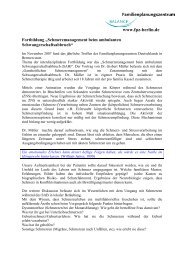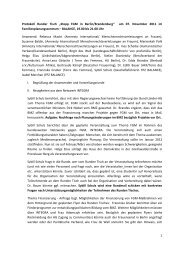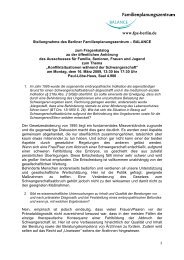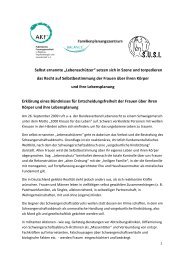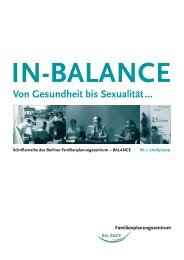Listening to African Voices - FPZ
Listening to African Voices - FPZ
Listening to African Voices - FPZ
Create successful ePaper yourself
Turn your PDF publications into a flip-book with our unique Google optimized e-Paper software.
Up <strong>to</strong> the present time, many communities in Sub-SaharanAfrica have considered FGM/C <strong>to</strong> be a sacred and ancienttradition that has been passed on from one generation <strong>to</strong>the next. It is a source of pride and identity for the women(Ahmadu 2000; Asefaw 2007). As such, it has become acollective norm. There is a strong social pressure <strong>to</strong> conform<strong>to</strong> the tradition, <strong>to</strong> belong <strong>to</strong> the circle of those who haveundergone it. Non-circumcised girls and their families areoften marginalised <strong>to</strong> an extent that their survival opportunitiesare reduced. The girls have little chance of finding a husbandwhile parents and other family members are excludedfrom social support systems, community gatherings and aredenied leading positions within the community.The number of beliefs associated with the practice is long.Many of them make the practice look advantageous. It is, forinstance, said <strong>to</strong>:• facilitate sexual intercourse, <strong>to</strong> enhance the fertility of awoman and <strong>to</strong> make giving birth easier;• increase hygiene, <strong>to</strong> purify the woman and <strong>to</strong> make hergenitals look more beautiful;• complete the girl, <strong>to</strong> make her become a true woman(while non-circumcised women are considered children);• free the woman of a dangerous organ (in some cultures,the cli<strong>to</strong>ris is considered <strong>to</strong> be a precarious organ that canmake the men sterile, kill the newborn or destroy farmland);• help a woman <strong>to</strong> have normal children;• decrease the risk of promiscuous behaviour in women andincrease their faithfulness.The last point is the most recurrently cited motive across<strong>African</strong> communities. FGM/C is performed <strong>to</strong> preserve thevirginity of the girl, <strong>to</strong> diminish her sexual appetite and <strong>to</strong>transform her in<strong>to</strong> an obedient and faithful wife and motherwho will not dishonour the family. In fact, the most commonobjective of FGM/C is <strong>to</strong> control the women’s sexuality(see for example Koso-Thomas 1987; Asefaw 2007). In thenetwork of societal rules, FGM/C is bound <strong>to</strong> values thatgive the woman an inferior status <strong>to</strong> the man (UNICEF 2005;Behrendt 2006).FGM/C is a cultural practice that predates both Christianityand Islam. Numerous Christians and Muslims, however,believe that the practice is a religious requirement or recommendation(see for example Behrendt 2005; UNICEF 2005).Furthermore, many communities associate the practice withsupernatural powers, demons and witchcraft. Those whodiscontinue the practice are said <strong>to</strong> become cursed and <strong>to</strong> bepossessed by evil spirits (Behrendt 2005).4.5. Sources for further readingFor further reading on FGM/C (e.g. on socio-cultural orreligious motive, the legislative texts regarding the practiceat country, regional and international level or movements forits abolition), we recommend the following documents: Thecontroversy of Female Genital Mutilation (Irin 2005), Changinga harmful social convention: female genital mutilation/cutting (UNICEF 2005). Tradition and rights: female genitalcutting in West Africa (Plan International 2006).To deepen the understanding of the medical and psychologicalharm of FGM/C, we propose two documents publishedby the WHO:• Eliminating female genital mutilation: an interagency statement(UNAIDS, UNDP et al. 2008)• Female genital mutilation and obstetric outcome: WHOcollaborative prospective study in six <strong>African</strong> countries(WHO study group on female genital mutilation andobstetric outcome 2006).4.6. FGM/C in EuropeThe European Parliament affirms in a press release in 2009that about 18,000 women and girls living in Europe undergoFGM/C or are threatened with having <strong>to</strong> undergo the practiceevery year (European Parliament 2009). The rationaleand sources used for establishing this number are notexplained. None of the European countries has carried outprevalence studies. The available countrywide estimationsare usually based on existing data from practicing countries.This method of transferring country prevalence rates <strong>to</strong>migrant populations has strong methodological limitations(Powell, Leye et al. 2004).4.6.1. Documentation of FGM/C performed in EuropeDue <strong>to</strong> lack of accurate data, the extent of the issue amongimmigrant communities in Europe is unknown. The documentationof court cases is the most solid indica<strong>to</strong>r for theexistence of girls being subjected <strong>to</strong> FGM/C in Europe.France is the pioneer in this regard and has by far the highestincidence of prosecutions and convictions: in the past 30years over 30 cases have been brought <strong>to</strong> court and parentsas well as practitioners have been condemned <strong>to</strong> prisonpenalties. Isolated prosecutions have also taken place in Italy,England and Sweden (Irin 2005; Sandberg 2008). Diverseother sources report indications that FGM/C is being practicedin Europe without providing tangible evidence (see forexample Black and Debelle 1995; Leye, Powell et al. 2006).<strong>Listening</strong> <strong>to</strong> <strong>African</strong> <strong>Voices</strong> 23






